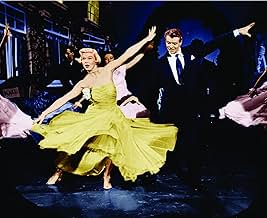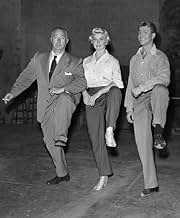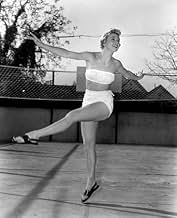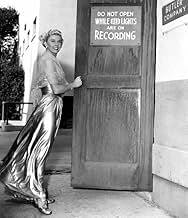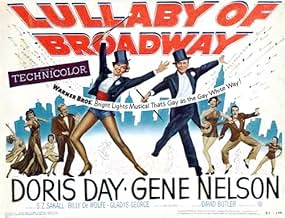IMDb RATING
6.7/10
1.3K
YOUR RATING
A showgirl returns to her New York home to visit her alcoholic mother, where she catches the eye of a Broadway producer.A showgirl returns to her New York home to visit her alcoholic mother, where she catches the eye of a Broadway producer.A showgirl returns to her New York home to visit her alcoholic mother, where she catches the eye of a Broadway producer.
- Awards
- 2 wins total
Bill Alcorn
- Dancer
- (uncredited)
Murray Alper
- Joe the Bartender
- (uncredited)
Jimmy Aubrey
- Ship's Steward
- (uncredited)
Brooks Benedict
- Reporter
- (uncredited)
Lulu Mae Bohrman
- Party Guest
- (uncredited)
Tex Brodus
- Party Guest
- (uncredited)
- Director
- Writer
- All cast & crew
- Production, box office & more at IMDbPro
Featured reviews
If you love Fifties movie-musicals that stress music over story, "Lullaby of Broadway" is the prototype. It takes moviemaking back to the Astaire-Rogers films, which highlighted dancing, music, and wisecracking dialogue. "Lullaby" isn't quite "Top Hat", but it does represent a trend where old, sentimental hit tunes are given updated arrangements and settings.
In her autobiography, "Doris Day: Her Own Story" (published in 1976), the actress describes her early years as a contract player for Jack Warner and the heated disputes she had with the autocratic movie czar over miscasting and bad scripts. But in "Lullaby," there is virtually no script to complain about. It's mainly a revue. But what a revue! From Ray Heindorf's jazzy rendition of the old title tune (from "Gold Diggers of 1935") over the opening credits to the end, this movie clicks along in high gear from one showstopper to the next.
Day also recalled in her memoirs that "Lullaby" contained, by far, the toughest dance routines of any film she ever made. One especially challenging scene called for her to perform an intricate series of steps on a huge staircase while weighed down in a gold-lame dress. At first, she balked, warning the crew to have an ambulance waiting after the first take. With encouragement from the director David Butler and others, however, she managed to complete the number.
"Lullaby of Broadway" is not the best of the Day/Warners musicals--that distinction goes to "Calamity Jane" (1953)--but it's as good as the rest. With Gene Nelson as Day's love interest, Billy De Wolfe as a vaudevillian-turned-valet, and S. Z. Sakall as a Broadway "angel."
In her autobiography, "Doris Day: Her Own Story" (published in 1976), the actress describes her early years as a contract player for Jack Warner and the heated disputes she had with the autocratic movie czar over miscasting and bad scripts. But in "Lullaby," there is virtually no script to complain about. It's mainly a revue. But what a revue! From Ray Heindorf's jazzy rendition of the old title tune (from "Gold Diggers of 1935") over the opening credits to the end, this movie clicks along in high gear from one showstopper to the next.
Day also recalled in her memoirs that "Lullaby" contained, by far, the toughest dance routines of any film she ever made. One especially challenging scene called for her to perform an intricate series of steps on a huge staircase while weighed down in a gold-lame dress. At first, she balked, warning the crew to have an ambulance waiting after the first take. With encouragement from the director David Butler and others, however, she managed to complete the number.
"Lullaby of Broadway" is not the best of the Day/Warners musicals--that distinction goes to "Calamity Jane" (1953)--but it's as good as the rest. With Gene Nelson as Day's love interest, Billy De Wolfe as a vaudevillian-turned-valet, and S. Z. Sakall as a Broadway "angel."
In a different perspective of the plot for Lady For A Day, Warner Brothers gave Doris Day one of her best musical films in Lullaby Of Broadway. They even tributed Busby Berkeley somewhat in the finale number.
The story involves Doris as a young performer who has spent her childhood in the United Kingdom with money sent to her by her mother who she believes is a famous Broadway star. That's in the past tense unfortunately mom who is played by Gladys George now sings in a cheap cabaret in the seamier parts of Greenwich Village.
But Doris is such a good kid that everyone tries to keep the illusion going from former vaudeville colleagues Billy DeWolfe and Anne Triola to S.Z. Sakall whom they now work for as butler and maid. She even gets involved with rising new Broadway performer Gene Nelson. But she also innocently almost breaks up S.Z. Sakall's marriage to Florence Bates. Now there's a couple to contemplate about.
In her memoirs Doris Day said that S.Z. Sakall in real life was the same lovable uncle type that he played so well in films. And yes no one could resist pinching those cheeks either.
Gene Nelson sad to say came along just a half generation too late to become a major film star. He had the moves and he had the talent, possibly he was not a creative individual in the way that Fred Astaire or Gene Kelly was. I think he was in their league as a performer and he'd be as known as they are today if he had that creative talent that they did which is why they've become the legends they are. Maybe Nelson never got the chance they did. Anyway this was his only lead in a major motion picture and it didn't make him a star because musicals were on the downside.
Gladys George has only a few scenes, but she really makes them count when she's on screen. One of her more memorable characters in earlier years was the Texas Guinan like performer in The Roaring Twenties who carries a torch for James Cagney. When that film ends she's singing in a dive and her character could be an extension of Panama whom she played in The Roaring Twenties.
As often as not for Doris Day films Warner Brothers reached into their trunk catalog and in this case got the title song and another standard written by Harry Warren and Al Dubin, You're Getting To Be A Habit With Me. Here though they outdid themselves for Doris and Gene using stuff like Somebody Loves Me and Just One Of Those Things. When you've got George Gershwin and Cole Porter contributing to the score the rest doesn't even matter.
Watching the finale number which is the title song, sung by Doris and danced by Gene Nelson and a chorus it plays very similar to the choreographic sequences in Golddiggers of 1935 where Lullaby Of Broadway was introduced. No kaleidoscopic overhead shots that characterized those old Warner Brothers musicals from the Thirties are here, but in all other respects they seem to have copied Mr. Berkeley well.
Lullaby Of Broadway has a nice backstage plot, it's a throwback to their musicals of the Depression in many respects and it provides Doris Day with many opportunities to display singing and dancing talents. And it holds up well today.
The story involves Doris as a young performer who has spent her childhood in the United Kingdom with money sent to her by her mother who she believes is a famous Broadway star. That's in the past tense unfortunately mom who is played by Gladys George now sings in a cheap cabaret in the seamier parts of Greenwich Village.
But Doris is such a good kid that everyone tries to keep the illusion going from former vaudeville colleagues Billy DeWolfe and Anne Triola to S.Z. Sakall whom they now work for as butler and maid. She even gets involved with rising new Broadway performer Gene Nelson. But she also innocently almost breaks up S.Z. Sakall's marriage to Florence Bates. Now there's a couple to contemplate about.
In her memoirs Doris Day said that S.Z. Sakall in real life was the same lovable uncle type that he played so well in films. And yes no one could resist pinching those cheeks either.
Gene Nelson sad to say came along just a half generation too late to become a major film star. He had the moves and he had the talent, possibly he was not a creative individual in the way that Fred Astaire or Gene Kelly was. I think he was in their league as a performer and he'd be as known as they are today if he had that creative talent that they did which is why they've become the legends they are. Maybe Nelson never got the chance they did. Anyway this was his only lead in a major motion picture and it didn't make him a star because musicals were on the downside.
Gladys George has only a few scenes, but she really makes them count when she's on screen. One of her more memorable characters in earlier years was the Texas Guinan like performer in The Roaring Twenties who carries a torch for James Cagney. When that film ends she's singing in a dive and her character could be an extension of Panama whom she played in The Roaring Twenties.
As often as not for Doris Day films Warner Brothers reached into their trunk catalog and in this case got the title song and another standard written by Harry Warren and Al Dubin, You're Getting To Be A Habit With Me. Here though they outdid themselves for Doris and Gene using stuff like Somebody Loves Me and Just One Of Those Things. When you've got George Gershwin and Cole Porter contributing to the score the rest doesn't even matter.
Watching the finale number which is the title song, sung by Doris and danced by Gene Nelson and a chorus it plays very similar to the choreographic sequences in Golddiggers of 1935 where Lullaby Of Broadway was introduced. No kaleidoscopic overhead shots that characterized those old Warner Brothers musicals from the Thirties are here, but in all other respects they seem to have copied Mr. Berkeley well.
Lullaby Of Broadway has a nice backstage plot, it's a throwback to their musicals of the Depression in many respects and it provides Doris Day with many opportunities to display singing and dancing talents. And it holds up well today.
After living in England, bubbly American singer-dancer Doris Day (as Melinda Howard) sails for New York. Aboard ship, Ms. Day meets likewise inclined Gene Nelson (as Tom Farnham), a Broadway star, homeward bound. The two are mutually attracted, but Day finds Mr. Nelson too forward. Day expects to return to her mother's mansion, but the house had been sold to blustery German brewer S.Z. Sakall (as Adolph Hubbell). A former Broadway star, Day's mother Gladys George (as Jessica Howard) has hit the skids, and is trying to lay off the sauce. Butler Billy De Wolfe (as Lefty Mack) tries to hide the truth from Day...
"Lullaby of Broadway" wisely brings Gene Nelson back for more singing and dancing with Doris Day. They had created momentary magic in a previous minor picture, "Tea for Two" (1950). Jumping on a piano and dancing incredibly with Day on a staircase, Nelson moves up to leading man, herein. While the co-stars are wonderful, the production has the appearance of quickly being thrown together, with familiar songs and reheated story lines. Strangely, Nelson's singing is dubbed. However, Day and Nelson are marvelous. One wonders what they would do at MGM, if afforded material like "Singing in the Rain" (1952).
****** Lullaby of Broadway (3/26/51) David Butler ~ Doris Day, Gene Nelson, Gladys George, S. Z. Sakall
"Lullaby of Broadway" wisely brings Gene Nelson back for more singing and dancing with Doris Day. They had created momentary magic in a previous minor picture, "Tea for Two" (1950). Jumping on a piano and dancing incredibly with Day on a staircase, Nelson moves up to leading man, herein. While the co-stars are wonderful, the production has the appearance of quickly being thrown together, with familiar songs and reheated story lines. Strangely, Nelson's singing is dubbed. However, Day and Nelson are marvelous. One wonders what they would do at MGM, if afforded material like "Singing in the Rain" (1952).
****** Lullaby of Broadway (3/26/51) David Butler ~ Doris Day, Gene Nelson, Gladys George, S. Z. Sakall
I saw this when I was a small boy, when it was revived in a neighborhood theatre, and then many years later on TV. Finally, with the advent of the VCR, I purchased this entertaining musical.
This is probably the picture that caused me fall in love with Doris Day. That personality! That smile! That Voice! From the opening number, "Just One of Those Things," to the last spectacular song and dance of "Lullaby of Broadway," this is a delight.
I especially enjoyed Doris' scenes with Gladys George (not "Cooper") as someone else reported. "It's tough being a mother. I need a couple more rehearsals." She was wonderful as Jessica Howard, has-been star of Broadway, now singing in a Greenwich Village dive.
Gene Nelson was mischievous as the lecherous dancer who chases Miss Day and Billy DeWolfe was inappropriately prissy as the "boyfriend" of Ann Triola. Of course, I always enjoy watching S. Z. "Cuddles" Sakall. This was his third time appearing with Miss Day.
Doris looked fantastic in Technicolor and the many closeups they gave her underscored her natural beauty, even though her freckles were covered up. She sang very nicely and danced up a storm with Gene Nelson, something that if done today, would get Oscar nominations. I especially enjoyed "You're Getting to Be a Habit with Me" and "I Love The Way You Say Goodnight." I was disappointed that Miss Day didn't have a ballad in this picture. What an oversight!
Day and her ilk made it look too easy, even though a LOT of work went into making these films.
This is probably the picture that caused me fall in love with Doris Day. That personality! That smile! That Voice! From the opening number, "Just One of Those Things," to the last spectacular song and dance of "Lullaby of Broadway," this is a delight.
I especially enjoyed Doris' scenes with Gladys George (not "Cooper") as someone else reported. "It's tough being a mother. I need a couple more rehearsals." She was wonderful as Jessica Howard, has-been star of Broadway, now singing in a Greenwich Village dive.
Gene Nelson was mischievous as the lecherous dancer who chases Miss Day and Billy DeWolfe was inappropriately prissy as the "boyfriend" of Ann Triola. Of course, I always enjoy watching S. Z. "Cuddles" Sakall. This was his third time appearing with Miss Day.
Doris looked fantastic in Technicolor and the many closeups they gave her underscored her natural beauty, even though her freckles were covered up. She sang very nicely and danced up a storm with Gene Nelson, something that if done today, would get Oscar nominations. I especially enjoyed "You're Getting to Be a Habit with Me" and "I Love The Way You Say Goodnight." I was disappointed that Miss Day didn't have a ballad in this picture. What an oversight!
Day and her ilk made it look too easy, even though a LOT of work went into making these films.
I was only familiar with Doris Day from her later romantic comedies of the late 50's and 60's, many with Rock Hudson. I also was a fan of her T.V. Show and her great Hitchcock movie with Jimmy Stewart, "The Man Who Knew Too Much." This was the first of her early movies that I have seen, and she is simply sunshine in a bottle. She seems to be enjoying every minute of every scene. Her joy is infectious. It is hard to watch the film and not respond to her by cheering up, no matter how your day may be going. Her supporting cast are also delightful and seem to be enjoying themselves. It was great to see Gladys George repeating her "Shantytown" song which she sang to James Cagney in "Twentieth Century" 13 years before. Billy De Wolfe is total gay delight as butler. He explains that he is really an actor, but took the butler job because of a "crazy, mad desire to keep from starving." Anne Triola compliments him perfectly as his maid/fiancé and they do an hilarious duet together. S.Z. Sakill steals the show as the flirtatious Broadway angel who is using his wife's money behind her back to invest in shows so he can oogle the actresses. Finally, there's Gene Nelson as Doris Day's song and dance partner. I have never seen him before, but he is quite a good dancer. At the beginning a fan tells him that he's the best dancer in the world. "It's you and me against Fred Astaire," he says. He does dance in Fred Astaire's style and is about as close to Astaire as anybody is likely to get. Typically, the male leads in musicals are the biggest problems, unless,they're Fred Astaire, Gene Kelley, or James Cagney, they're usually good dancers who can't act or good actors who can't really dance. Here, we seem to have somebody who can do both. The double plot has a) Doris Day coming back to New York to see her mother who she thinks is a big star, but is only an alcoholic cabaret singer, and b)some Broadway entertainers trying to entice S.Z. Sakill to invest his wife's money in a Broadway show. Not too original, but great one liners keep it moving cheerfully along between about a dozen small scale musical numbers. The director wisely understood that with Doris Day singing, you don't need Busby Berkeley super-sets or super choruses. This is a must for Doris Day fans and a wide toothy smile for everybody else.
Did you know
- TriviaWhen Doris Day's character is questioned by reporters about an affair she's supposedly having with S.Z. Sakall's character, one of them asks her, "Is it true you call him 'Cuddles'?" This is an inside joke, as Sakall's nickname in real life was "Cuddles".
- GoofsGloria reads a copy of Variety with news on the back cover; in reality, the back cover of this publication has always been reserved for full-page ads.
- Quotes
Melinda Howard: [handing Tom a penny] There's a message on that to you from the women of the world.
Tom Farnham: In God We Trust
- ConnectionsFeatured in The 69th Annual Academy Awards (1997)
- SoundtracksLullaby of Broadway
(uncredited)
Music by Harry Warren
Lyrics by Al Dubin
Sung by Doris Day
Danced by DDoris Day and Gene Nelson and mixed chorus
- How long is Lullaby of Broadway?Powered by Alexa
Details
- Release date
- Country of origin
- Language
- Also known as
- Das Wiegenlied vom Broadway
- Filming locations
- Production company
- See more company credits at IMDbPro
- Runtime1 hour 32 minutes
- Aspect ratio
- 1.37 : 1
Contribute to this page
Suggest an edit or add missing content





